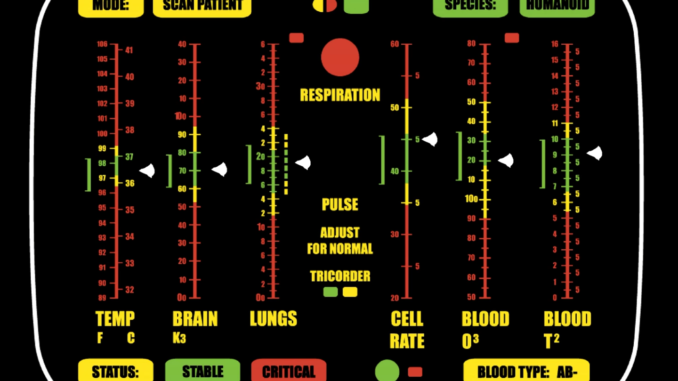
If you thought it was super cool that cellphones became a reality based on the original Star Trek series ‘flip-phone-style’ communicator, just wait for the tricorder. Not that Star Trek invented wireless communications: portable two-way radios had already been around since the 1930s and saw widespread use during the Second World War. Star Trek simply made walkie-talkies cool.
In Gene Roddenberry’s vision of the 23rd century, a tricorder did three things; sense, compute, and record. Also, there were at least three types of tricorders; one for general purpose use, one for Mr. Scott’s engineering section, and another for Dr. McCoy and the ship’s medical staff.
Star Trek didn’t invent electronic medical instruments either. The show imagined what the future of medicine would look like, and compressed all manner of medical instrumentation and tests into a single device that could tell a doctor just about everything there was to know about a patient’s state of health.
The science-fiction tricorder has inspired doctors, scientists, and engineers around the world and technology has evolved and improved enough to make 21st century tricorders possible. A number of startups and academic researchers have been working on practical devices that can noninvasively read a patient’s vital signs and other health metrics.
Commercialized, such devices have the potential to revolutionize healthcare in many ways. For example, when a patient has a tricorder at home, their doctor will be able to read vital signs remotely to determine if the patient is truly ill, and if so whether an office visit or hospitalization is necessary. This would be a vastly improved version of telemedicine, greatly increasing efficiency in healthcare. Also, tricorders could potentially speed up triage situations or improve population data collection during a pandemic.
A few examples of the vital signs a tricorder might possibly measure and record are; temperature, pulse, heart rate, blood pressure (systolic and diastolic), glucose, hemoglobin, cholesterol, respiratory function, and urinalysis. Different makes and models of commercial tricoders will have different features and functions and price tags, kinda like the automotive market.
There’s a very good reason everyone should want a tricorder at home. If you’re over 50 or 60 years old, you probably know that health issues come with the territory. If you could record your vital signs every day, you’d have a baseline history for reference. Any change in your vital signs or lab work is important to be aware of as it may indicate the need for healthcare attention.
If you’re not 50 or 60 yet, you still want a tricorder because having a baseline record of what’s normal for you is important. Lab results always indicate a range of what is considered healthy, but not everyone fits in the middle of a bell curve for every test. Besides, young people sometimes fall ill too and it’s always better to address a problem early.
Tricorder research and development has been ongoing for nearly twenty years, but it received a big shot in the arm in the last decade by the Qualcomm Tricorder XPRIZE competition .
The X-Prize Foundation announced the competition in 2011. The contest officially began in 2012 with 312 teams competing. Qualcomm and other organizations sponsored the race with financial contributions.
To win, a team’s tricorder had to detect 13 medical conditions – 12 diseases plus the absence of disease for a total of 13 conditions – including conditions such as anemia, atrial fibrillation, chronic obstructive pulmonary disease (COPD), diabetes, leukocytosis, pneumonia, otitis media, sleep apnea, and urinary tract infection. The tricorder also had to be able to record continuously 5 vital signs: blood pressure, heart rate, oxygen saturation, respiratory rate and temperature.
Two teams were named finalists, and four others named semi-finalists. Final Frontier Medical Devices (now renamed Basil Leaf Technology) was awarded $2.5 million, and Dynamical Biomarkers Group was awarded $1 million.
If you’d like some useful tools at home before tricorders come on the market, you might consider purchasing a pulse oximeter and a touchless forehead thermometer. Both are available online or at major pharmacy chain stores. These inexpensive instruments will sense and measure a couple of vital signs, but none (that I know of) will record the data or communicate with a computer or cellphone – so not as good as a tricorder, but still providing valuable health information.
Question of the Night: Colonoscopy or root canal?
